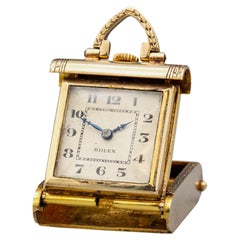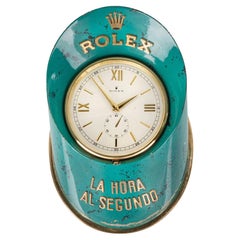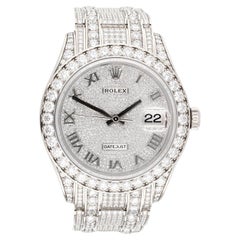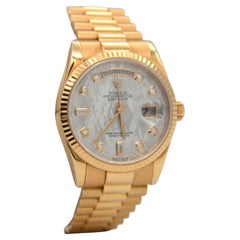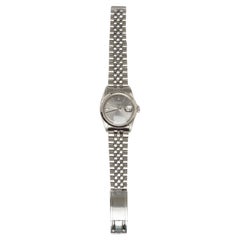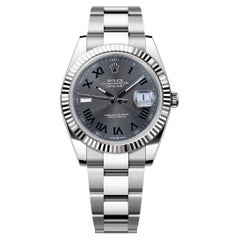Rolex Clock
Mid-20th Century Desk Accessories
9k Gold
Late 20th Century Swiss Desk Accessories
Brass
21st Century and Contemporary Wrist Watches
Diamond, 18k Gold, White Gold
21st Century and Contemporary Swiss Wrist Watches
Diamond, 18k Gold, Rose Gold
21st Century and Contemporary Swiss Modern Wrist Watches
21st Century and Contemporary Swiss Modern Wrist Watches
21st Century and Contemporary Wrist Watches
Diamond, 18k Gold
2010s Wrist Watches
White Gold
21st Century and Contemporary Modern Wrist Watches
Stainless Steel
20th Century Swiss Pocket Watches
Stainless Steel
2010s European Wrist Watches
Diamond, Stainless Steel
2010s Swiss Modern Wrist Watches
Stainless Steel
Vintage 1980s Swiss Wrist Watches
Diamond, 18k Gold, Yellow Gold
21st Century and Contemporary Swiss Wrist Watches
Gold, Steel
Mid-20th Century Swiss Modern Wrist Watches
14k Gold, Yellow Gold
2010s Swiss Wrist Watches
Stainless Steel
Early 2000s Swiss Wrist Watches
Yellow Gold, Stainless Steel
2010s Swiss Wrist Watches
Stainless Steel
Vintage 1950s Swiss Modern Wrist Watches
18k Gold, Yellow Gold
2010s Swiss Wrist Watches
Stainless Steel
2010s Swiss Wrist Watches
Stainless Steel
Late 20th Century Swiss Wrist Watches
Diamond, 18k Gold, Yellow Gold
1990s Swiss Wrist Watches
Diamond, 18k Gold
Early 2000s Swiss Wrist Watches
Stainless Steel
1990s Swiss Wrist Watches
Stainless Steel
21st Century and Contemporary Swiss Modern Wrist Watches
2010s Swiss Wrist Watches
Stainless Steel
Early 2000s Swiss Wrist Watches
Gold, Steel
2010s Swiss Wrist Watches
Gold, Steel
Early 2000s Swiss Wrist Watches
Yellow Gold, Stainless Steel
2010s Swiss Wrist Watches
Gold, Stainless Steel
Early 2000s Swiss Wrist Watches
Gold, Steel
2010s Swiss Wrist Watches
Diamond, Stainless Steel
Vintage 1970s Swiss Wrist Watches
Stainless Steel
Early 2000s Swiss Wrist Watches
Stainless Steel
Early 2000s Swiss Wrist Watches
Stainless Steel
1990s Swiss Wrist Watches
Yellow Gold, Stainless Steel
2010s Swiss Wrist Watches
Gold, Steel
2010s Swiss Wrist Watches
Gold, Stainless Steel
Vintage 1970s Swiss Wrist Watches
Yellow Gold, Stainless Steel
Vintage 1960s Swiss Pocket Watches
21st Century and Contemporary Pocket Watches
21st Century and Contemporary Wrist Watches
Yellow Gold
Vintage 1950s Swiss Wrist Watches
18k Gold
2010s American Modern Wrist Watches
Vintage 1940s Swiss Post-War Wrist Watches
Gold, 18k Gold
Vintage 1960s Swiss Pocket Watches
20th Century Swiss Desk Accessories
Vintage 1970s Desk Accessories
Vintage 1930s Swiss Pocket Watches
Other
Vintage 1980s Swiss Wrist Watches
20th Century Swiss Desk Accessories
Vintage 1930s Swiss Pocket Watches
Other
Vintage 1950s Swiss Wrist Watches
18k Gold
21st Century and Contemporary Swiss Desk Accessories
21st Century and Contemporary Modern Wrist Watches
Platinum
21st Century and Contemporary European Modern Wrist Watches
Platinum
20th Century Wrist Watches
Gold, 18k Gold, Yellow Gold
- 1
Rolex Clock For Sale on 1stDibs
How Much is a Rolex Clock?
Rolex for sale on 1stDibs
While the rise in popularity of vintage Rolex watches is of no surprise to aficionados, collectors and industry experts, when it comes to contemporary luxury wristwatches, Rolex is also often the first brand that springs to mind. Not only is the company revered for its precision timekeeping and impeccable craftsmanship, but its name was designed to be memorable.
Rolex's enviable worldwide recognition can be credited in part to the genius of company founder Hans Wilsdorf. When the German-born watch dealer and his brother-in-law, Alfred Davis, set up their London enterprise, in 1905, they called it Wilsdorf & Davis, according to the traditional formula.
But Wilsdorf was determined to come up with another name that was short, would look good on a watch dial and was easy to say and remember in several languages. In 1908, he trademarked the name Rolex, and by 1920, he had moved the company to Geneva and redubbed it as Montres Rolex S.A.
But the main reasons for the brand’s success are its aforementioned commitment to precision and unflagging pursuit of innovation. In 1926, the company introduced the aptly named Oyster model. With a screw-down crown and case back, both fitted with rubber gaskets, this was the first truly waterproof watch.
Five years later, Rolex upped the ante with the Oyster Perpetual. That model’s patented Perpetual movement contained a rotor mechanism enabling it to self-wind. In another trendsetting move, in 1945, the brand debuted the Datejust, with a date window prominently displayed on the dial.
The company’s two most iconic models are sports watches. Although the Submariner, which debuted in 1953, was developed as a dive watch, its waterproof case, solid construction and good looks made it a favorite of adventurers and urbanites alike, including James Bond, who wore it in classics like Dr. No and Goldfinger. The Daytona, the racing chronograph made famous by Paul Newman, is especially sought after by collectors. Newman’s personal Daytona, which hit the auction block in 2017, sold for $17.8 million.
Find vintage Rolex watches, bracelets and more on 1stDibs.
Finding the Right Wrist-watches for You
Antique, vintage and luxury wristwatches have captured the hearts and minds of all manner of watch collectors as well as the watchmakers themselves — it's time you found your own.
Certain vintage watches for men and iconic watch designs for women are sought after not only because of their graceful proportions or innovative materials but also because of the illustrious histories of the houses that created them, histories that they stylishly embody.
Bulgari’s legendary Serpenti watch was on everyone’s list after the collection’s bold bracelet, which technically debuted after the timepiece, graced the wrist of actress Elizabeth Taylor. If anything, elaborately crafted timepieces — the unmistakably boxy silhouette of Cartier Tank watches, the elegant and minimal Calatrava designed by legendary Swiss house Patek Philippe — are even more effective than the shape we associate with traditional wristwatches.
Form watches — the all-encompassing moniker bestowed upon non-round watches — are making headlines and completing contemporary fashionable ensembles the world over. At the same time, both casual fans and careful collectors are drawn to the unbeatable charm of vintage styles, such as the icons designed by Omega that even James Bond can’t resist.
In the early days of watchmaking, watches were fragile enough that they necessitated protection from the elements. Now, wristwatches made of gold and steel can withstand the harshest climates — even 100 meters underwater, in the case of Rolex’s Submariner. Designer Gérald Genta, whose range of clients included Rolex, created for Audemars Piguet the first luxury sports timepiece to be made from stainless steel. First introduced in 1972, the Royal Oak was a perfect choice for blending the form and function that are now synonymous with sports watches.
Are you shopping for a wristwatch? It’s good to keep your needs as well as your specific personal style in mind: A smaller, subtle timepiece is a good fit for small wrists. When will you be wearing your new accessory? There’s a versatile model out there for everyday wear, while a rugged, feature-heavy watch is a safe bet if you’re prone to embarking on all-weather activities in the great outdoors.
Find antique, vintage and luxury wristwatches for sale on 1stDibs.
- 1stDibs ExpertDecember 17, 2024What is the cheapest Rolex ever made may vary over time as the luxury maker introduces new models. However, some watches made by Rolex are generally considered entry-level models based on their price points. These include the Oyster Perpetual, the DateJust 36mm, the Explorer 36mm, the Air King and the Milgaus. On 1stDibs, find a wide variety of Rolex watches.
- What is the rarest Rolex face?1 Answer1stDibs ExpertDecember 17, 2024There is no single rarest Rolex face, as the availability of the luxury watchmaker's timepieces does vary in response to changes in collecting trends. However, some faces are generally rarer than others due to limited production, age and other factors. Examples of such dials include those made of meteorite, onyx, malachite, bloodstone, tiger's eye, coral, wood and lapis lazuli. Find a wide range of Rolex watches on 1stDibs.
- What is the cheapest Rolex?1 Answer1stDibs ExpertFebruary 22, 2021The lowest priced Rolex model is the Oyster Perpetual. This watch retails for roughly $5,000. On 1stDibs, you can can find a variety of Rolex watches for sale.
- 1stDibs ExpertFebruary 22, 2021One of the cheapest Rolex watches is the Oyster Perpetual, which usually costs around $5,000. This model is made of oystersteel, an affordable type of steel.
- How to wind a datejust rolex?1 Answer1stDibs ExpertApril 5, 2022To wind a Rolex Datejust, set the crown notch (located on the right hand side of the face) to position one. To set it to position one, turn the crown counterclockwise to unscrew the crown and pop the crown out one notch. From this position, start to wind the Rolex by turning the crown clockwise. You should feel a bit of tension and hear a soft clicking sound. Browse a wide selection of Rolex Datejust watches on 1stDibs.
- Does Rolex make sunglasses?1 Answer1stDibs ExpertApril 5, 2022No, Rolex does not officially make sunglasses that are available for sale. They do however occasionally create promotional products, which have included sunglasses for sponsored events in the past. Browse a range of Rolex products that have been expertly authenticated on 1stDibs.
- 1stDibs ExpertFebruary 22, 2021The Rolex Oyster Perpetual is a great entry-level Rolex to purchase. The perpetual refers to the ability of the watch to use the energy of the wearer's wrist motion to run. It is a popular starter Rolex.
- 1stDibs ExpertFebruary 22, 2021A contemporary Rolex Yacht Master costs around $11,000. However, a vintage model can cost up to $30,000.
- What diamonds do Rolex use?1 Answer1stDibs ExpertFebruary 22, 2021Rolex uses only the highest quality diamonds in their watches and compares these stones against certified master stones. They are the most colorless, so in ranges D to G.
- 1stDibs ExpertFebruary 22, 2021While choosing a watch can depend on the wearer's style, there are a few consistent favorites. Some of the top Rolex watches for women include the Rolex Datejust, the Rolex Day-Date, and the Rolex Oyster Perpetual.
- 1stDibs ExpertFebruary 22, 2021The most expensive Rolex ever sold is the Paul Newman Daytona. This Rolex was purchased for $17.8 million in 2017. On 1stDibs, there are expensive Rolex watches but there is a wide variety available, so it should be easy to find a good fit for your tastes as well as your budget.
- 1stDibs ExpertOctober 19, 2021An Oyster Perpetual on a Rolex watch refers to the watch's ability to run on the energy generated by the wearer's wrist movements rather than manual winding. At Baselworld in 2015, a variety of Rolex watches with a new-generation Oyster Perpetual movement were unveiled. Find a variety of vintage Rolex watches on 1stDibs.
- 1stDibs ExpertFebruary 22, 2021The popular Rolex Oyster Perpetual is usually between $5,900 and $6,600 in price.
- 1stDibs ExpertFebruary 22, 2021Because platinum is denser than other metals, it is often more expensive to purchase platinum watches than gold. One of the most expensive watches sold was a Platinum Rolex worth $277,000.
- 1stDibs ExpertFebruary 22, 2021A new Rolex Oyster Perpetual Date watch is worth around $6,000. However, if it's encrusted with gems or vintage, it can cost as much as $50,000. 1stDibs has a great and vast selection of Rolex Oyster Perpetual Date watches.
- 1stDibs ExpertFebruary 22, 2021The new Submariner Rolex with a Black Bezel is worth around $8,100 with some of the more expensive new Submariners in yellow gold costing around $36,950.
- How do I wind a Rolex watch?1 Answer1stDibs ExpertMarch 22, 2022To wind a Rolex watch, first fully unscrew the winding crown. Once it is in a raised position, carefully turn the crown clockwise. Most watches require 25 turns for enough winding to begin powering the watch. The instructions included with Rolex watches provide more information about how to wind specific models. Shop a large collection of Rolex watches on 1stDibs.
- Is Panerai better than Rolex?1 Answer1stDibs ExpertFebruary 22, 2021Depending on what kind of watch you're looking for, one may be better than the other. For instance, if you want a highly functional sport watch, some of Rolex's models may be better for you. That said, the brands' watches are very similar quality-wise. The main difference is their appearances: While Rolex designs more traditional timepieces, Panerai is more contemporary and bold.
- 1stDibs ExpertApril 5, 2022A Rolex Submariner bears an 18k stamp and the number “750,” which means that 75 percent of the watch is made out of pure gold model. The most luxurious of all timepieces, the Rolex Submariner has been continuously manufactured since 1951. Find vintage Rolex watches on 1stDibs.
- Does Rolex use real diamonds?1 Answer1stDibs ExpertFebruary 22, 2021Rolex uses only the highest quality melee diamonds with between D and G in color and IF in clarity. Every diamond is tested individually to make sure it is real.
Read More
How to Spot a Fake Rolex: 13+ Expert Tips
Learn the devious techniques that counterfeiters use to sell inauthentic pieces at authentic prices. Of course, you don't have to worry about that on 1stDibs, where every seller of Rolex watches is highly vetted.
Rolex Buying Guide: Everything You Need to Know about Choosing the Right Watch
From understanding the models to choosing among vintage, pre-owned and new watches, here’s our expert advice on finding the best Rolex for you.
Get a Glimpse at One of the Most Valuable Watch Collections in the World
As the cache goes on display at London’s Design Museum, we speak to its enigmatic owner about some of his rarest acquisitions.
The 6 Most Popular Brands for Luxury Watches
These companies have stood the test of time, making exceptional pieces for generations.
How Paul Newman Made the Rolex Daytona the Epitome of Cool
In the early 1970s almost no one wanted Rolex Daytonas. Now Jay-Z gives them out as party favors.
The Personal Luxury Goods Market amid COVID-19
1stDibs dealers discuss the challenges of this unprecedented time, and the signs of hope.
Why Vintage Watches Are Making a Comeback
Men, women and the watchmakers themselves are falling for the old-fashioned charm of retro timepieces.
